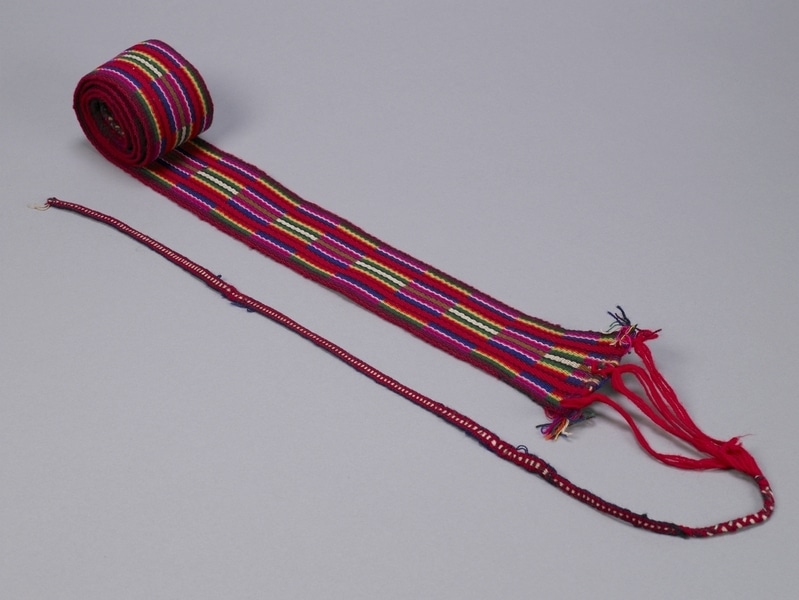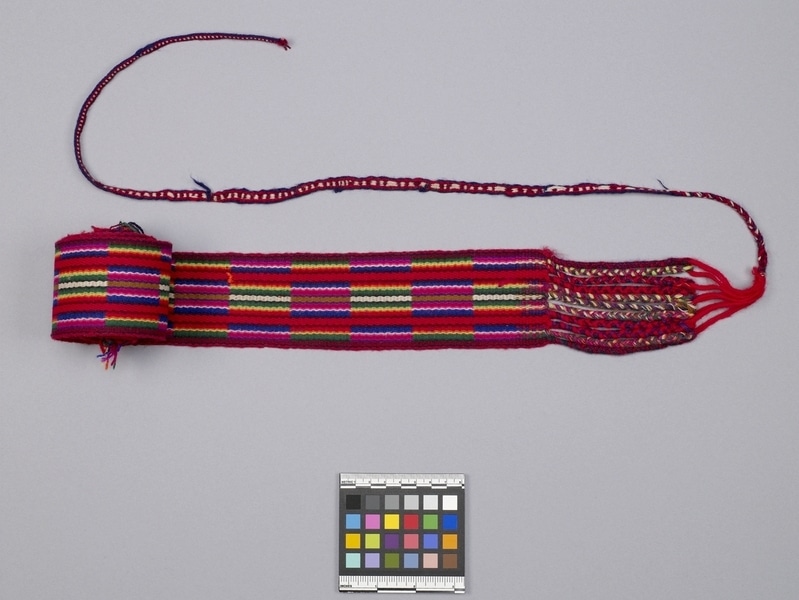Belt Item Number: Sf1012 from the MOA: University of British Columbia


Description
Belt woven with colour blocks arranged in a series of graduated hues ranging from light to dark and including the entire colour spectrum. Two separate colour series alternate on one face in blocks about 4 cm wide. One end is finished with a braided fringe. Attached to both ends by yarns are loosely woven narrow ties. The ties are red, white and black.
History Of Use
Warp-faced fabric with three or four selvedges are woven by women but the fabrics are used by both sexes. The techniques, structures and some of the motifs have pre-Conquest antecedents. This type of textile conveys the most information about an individual's ethnicity, sex, age, status and particular history. Women on Taquile wear, on a daily basis, a thick striped belt with chevron patterns. This belt has a different weave structure and stripe pattern but is similar in general characteristics. Women wear thick belts particularly during and after pregnancy. During pregnancy, they are worn tightly to keep the baby from growing too large and making the birth difficult. The belts are also used to swaddle infants.
Narrative
Bought from the maker, a young married woman with 2 children. Florentina worked out the shedding necessary to reproduce this 2 faced weave from an old belt which she said belonged to her grandmother. Florentina's 6 year old daughter, Telma, wove parts of the end ties. Florentina, a nursing mother, was wearing her belt tied tightly above her breasts and under her arms on the day the belt was purchased. Florentina is one of the most skilful and innovative weavers on Taquile. She is able to analyze weave structures from old or unusual textiles and work out how to reproduce them.
Specific Techniques
Commercial synthetic yarns are retwisted in the plying (s) direction. The structure is a double-faced complementary warp weave with 3 span floats. The terminal area is braided on grouped warps in 3 strand oblique interlacing. Narrow ties in plain weave (with many mistakes) are knotted onto yarn ties at both ends.
Item History
- Made by Florentina Huatta Huatta (Maker) in Taquile, Puno, Peru between 1986 and 1987
- Collected by Mary Frame during 1987
- Owned by Mary Frame before November 3, 1987
- Received from Mary Frame (Seller) and Museum of Anthropology Shop Volunteers (Funding source) on November 3, 1987
What
Who
- Culture
- Quechua
- Creator
- Florentina Huatta Huatta (Maker)
- Field Collector
- Mary Frame
- Previous Owner
- Mary Frame
- Received from
- Mary Frame (Seller) and Museum of Anthropology Shop Volunteers (Funding source)
Where
- Holding Institution
- MOA: University of British Columbia
- Made in
- Taquile, Puno, Peru
When
- Creation Date
- between 1986 and 1987
- Collection Date
- during 1987
- Ownership Date
- before November 3, 1987
- Acquisition Date
- on November 3, 1987
Other
- Item Classes
- textiles
- Condition
- good
- Accession Number
- 1274/0009